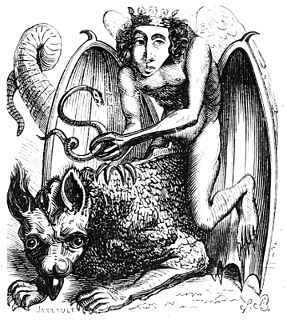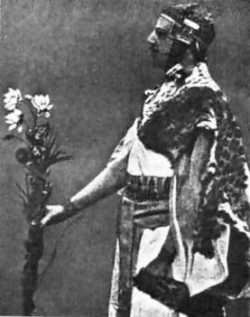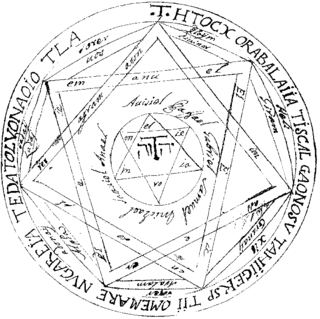
The Enchiridion or Handbook of Epictetus is a short manual of Stoic ethical advice compiled by Arrian, a 2nd-century disciple of the Greek philosopher Epictetus. Although the content is mostly derived from the Discourses of Epictetus, it is not a summary of the Discourses but rather a compilation of practical precepts. Eschewing metaphysics, Arrian focuses his attention on Epictetus's work applying philosophy to daily life. The book is thus a manual to show the way to achieve mental freedom and happiness in all circumstances.
A pentacle is a talisman that is used in magical evocation, and is usually made of parchment, paper, cloth, or metal, upon which a magical design is drawn. Protective symbols may also be included, a common one being the six-point form of the Seal of Solomon.

Astaroth, in demonology, is the Great Duke of Hell in the first hierarchy with Beelzebub and Lucifer; he is part of the evil trinity. He is a male figure most likely named after the Mesopotamian goddess Ishtar.

In demonology, Barbatos is an earl and duke of Hell, ruling thirty legions of demons and has four kings as his companions to command his legions. He can speak to animals, can tell the future, conciliates friends and rulers, and can lead men to treasure hidden by the enchantment of magicians.

Baal is one of the seven princes of Hell in 17th-century goetic occult writings. The name is drawn from the Canaanite deity Baal mentioned in the Hebrew Bible as the primary god of the Phoenicians.
The Lesser Key of Solomon, also known as Clavicula Salomonis Regis or Lemegeton, is an anonymous grimoire on demonology. It was compiled in the mid-17th century, mostly from materials a couple of centuries older. It is divided into five books—the Ars Goetia, Ars Theurgia-Goetia, Ars Paulina, Ars Almadel, and Ars Notoria.

Goetia or Goëtia is a practice that includes the conjuration of demons, specifically the ones summoned by the Biblical figure, King Solomon. The use of the term in English largely derives from the 17th-century grimoire Lesser Key of Solomon, which features an Ars Goetia as its first section. It contains descriptions of the evocation, or "calling out", of seventy-two demons, famously translated from Latin into English by S. L. MacGregor Mathers and published by Aleister Crowley in 1904 as The Book of the Goetia of Solomon the King.
In demonology, Amaymon is a Prince of Hell, and, according to some Grimoires, the only one who has power over Asmodai.

Buer is a spirit that appears in the 16th-century grimoire Pseudomonarchia Daemonum and its derivatives, where he is described as a Great President of Hell, having fifty legions of demons under his command. He appears when the Sun is in Sagittarius. He teaches natural and moral philosophy, logic, and the virtues of all herbs and plants, and is also capable of healing all infirmities and bestows good familiars.

Samuel Liddell MacGregor Mathers, born Samuel Liddell Mathers, was a British occultist. He is primarily known as one of the founders of the Hermetic Order of the Golden Dawn, a ceremonial magic order of which offshoots still exist today.
The Book of Abramelin tells the story of an Egyptian mage named Abraham, or Abra-Melin, who taught a system of magic to Abraham of Worms, a Jew in Worms, Germany, presumed to have lived from c.1362–c.1458. The system of magic from this book regained popularity in the 19th and 20th centuries partly due to Samuel Liddell MacGregor Mathers' translation, The Book of the Sacred Magic of Abramelin the Mage; and partly to its importance within the Hermetic Order of the Golden Dawn, and later within the mystical system of Thelema.
The rabbinical translations of Matthew are rabbinical versions of the Gospel of Matthew that are written in Hebrew; Shem-Tob's Matthew, the Du Tillet Matthew, and the Münster Matthew, and which were used in polemical debate with Catholics.

A lamen is a magical pendant or breastplate worn around the neck so that it hangs upon the breast over the heart. Its uses vary but, most commonly, the term refers to a symbol of authority and a focus of magical energies. Aleister Crowley described the lamen as "a sort of Coat of Arms. It expresses the character and powers of the wearer." Crowley and DuQuette have proposed that the magical lamen might be a modern adaptation of the priestly breastplate of the ancient Hebrews.
Abramelin oil, also called Oil of Abramelin, is a ceremonial magic oil blended from aromatic plant materials. Its name came about due to its having been described in a medieval grimoire called The Book of Abramelin written by Abraham the Jew. The recipe is adapted from the Jewish Holy anointing oil of the Tanakh, which is described in the Book of Exodus (30:22-25) attributed to Moses.
Turiel is a fallen Watcher in the ancient apocryphal text known as the Book of Enoch. In later translations, he is one of the 20 leaders of 200 fallen angels, mentioned eighteenth. The name is believed to originate from tuwr "rock" and El "God", meaning "rock of God", while the translation taken from M. A. Knibb's work on the Ethiopic Book of Enoch is either "Mountain of God" or "Rock of God".

The Mathers table of Hebrew and "Chaldee" letters is a tabular display of the pronunciation, appearance, numerical values, transliteration, names, and symbolism of the twenty-two letters of the Hebrew alphabet appearing in The Kabbalah Unveiled, S.L. MacGregor Mathers' late 19th century English translation of The Kabbalah Denudata, itself a Latin translation by Christian Knorr von Rosenroth of the Zohar, a primary Kabbalistic text.
The Grimorium Verum is an 18th-century grimoire attributed to one "Alibeck the Egyptian" of Memphis, who purportedly wrote in 1517. Like many grimoires, it claims a tradition originating with King Solomon.
The Galdrabók is an Icelandic grimoire dated to ca. 1600. It is a small manuscript containing a collection of 47 spells and sigils/staves. The grimoire was compiled by four different people, possibly starting in the late 16th century and going on until the mid-17th century. The first three scribes were Icelanders, and the fourth was a Dane working from Icelandic material. The various spells consist of Latin and runic material as well as Icelandic magical staves, invocations to Christian entities, demons and the Norse gods, as well as instructions for the use of herbs and magical items. Some of the spells are protective, intended against such problems as trouble with childbearing, headache and insomnia, previous incantations, pestilence, suffering and distress at sea. Others are intended to cause fear, kill animals, find thieves, put someone to sleep, cause flatulence, or bewitch women.












